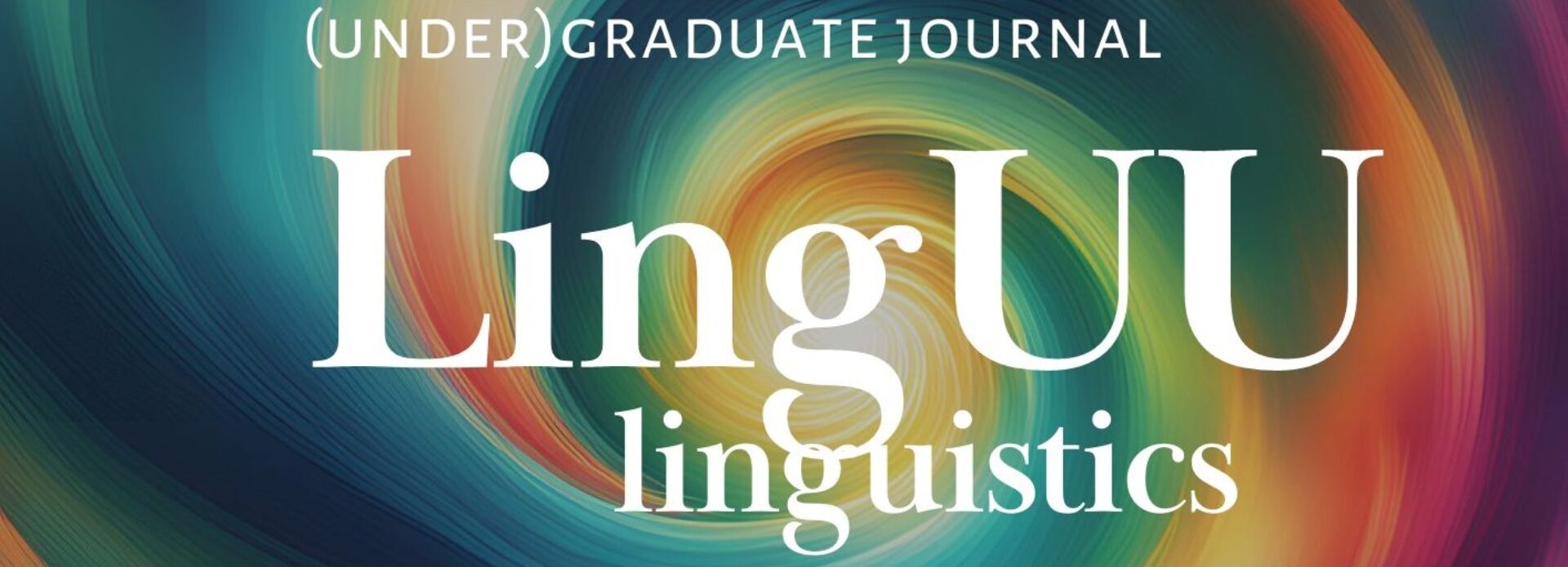We are so happy that we have published LingUU 7.2! We would like to thank everyone who contributed to the journal. To our authors, please know that your hard word has now been immortalised and that we are grateful that you entrusted us with your research! The authors can be found below. Enjoy!
Category: Geen categorie
LingUU 7.1 is out now!
LingUU 7.1 is out now! The seventh issue of LingUU Journal features articles on various linguistic topics, written by students from different BA and MA programmes. Download the entire issue, browse through the contents, or order a paper copy.
In her paper Cristina Reguera–Gómez uses SPE and autosegmental phonology as analysis tools, in order to measure the role of stress on dissimilation of the conjunction y in Spanish. Her findings support that stress is as important as dissimilation to ensure that the conjunction does not conflate with a neighbouring sound.
Bianca Mădălina Zgreabăn presents a step-by-step analysis of Romanian weak definites undergoing incorporation. Zgreabăn does so by extending a previously suggested analysis by applying the Discourse Representation Theory framework. A review is also made on both favorable and unfavorable arguments regarding weak definites undergoing semantic incorporation.
Bram van Beerendonk investigates how gravity and skewness of /s/ predict gay identity of young Dutch men in English as a second language. This was tested by recording the elicitation of spontaneous speech from 11 men (ages 20-25) and later on performing statistical analysis on the phonetical analysis of these recordings. According to the measurements, a more negatively skewed /s/ significantly predicted gay identity.
In this paper, Jiayi Zhou explores the adverbial NP (Noun Phrase) – shang as a case study of Chinese–Japanese language contact influenced by the use of the Chinese character shang. This discussion explores not only the adverbialized NP- shang itself along with its causes and paths of adverbialization, but also the paths and the effects of Chinese-Japanese language contact.
In her proposal, Martina Cola conducts a visual word paradigm eye-tracking experiment to investigate the processing of subjectivity of the Italian impersonal si constructions in neurotypically developed and autistic Italian monolingual native speakers.
In the column Intern Extern two second-year RMA linguistics students describe their experiences during their internship. Filipe de Carvalho interned at a tech company (Yoast Bv.), and thus worked outside of academia, whereas Sofia Archimandriti conducted her internship at the Max Planck Institute.
The Daily Linguist recommends some interesting linguistics related articles and discusses potential study and student associations you can join.
Launch event LingUU 7.1

The wait is almost over: LingUU 7.1 will be published online in two days!
To celebrate the launch of our new issue, we’re hosting our first in-person event since 2019! Join us on the 8th of June at Café De Stadsgenoot in Utrecht for a pub lecture by Anika van der Klis, followed by a pub quiz hosted by Louise Lalande. We hope to see you there at 19.00 and join us afterward for drinks as well. Check out the abstract for Anika’s lecture below.
Pub lecture: “Infants’ vocalisations and gestures elicit different responses from caregivers: implications for language development”
Abstract: Caregivers use a range of verbal and nonverbal behaviours when responding to their infants. Previous studies have focused on the role of the caregiver in providing verbal responses, while communication is inherently multimodal (involving audio and visual information) and bidirectional (exchange of information between infant and caregiver). It is not known to what extent caregivers produce nonverbal or multimodal responses, and to what extent such caregiver responses are elicited by different infant behaviours. For this study, we annotated six minutes of free play in 117 caregiver-child dyads. This resulted in a large dataset consisting of 2036 vocalisations and gestures of which 87% received a caregiver response. Most caregiver responses were verbal, but almost 40% of those were multimodal – containing an additional nonverbal cue (i.e., gesture, facial expression, or body movement). We found that infants’ bimodal behaviours (gesture-speech combinations) were more likely to receive a verbal or multimodal response compared to unimodal behaviours. While infants’ gestures elicited high nonverbal response rates, index-finger pointing elicited high verbal response rates. Infants show large variability in the frequency and types of vocalisations and gestures they produce, which in turn affect when and how their caregivers respond – thereby shaping their early learning environments.
LingUU 5.2 out now!
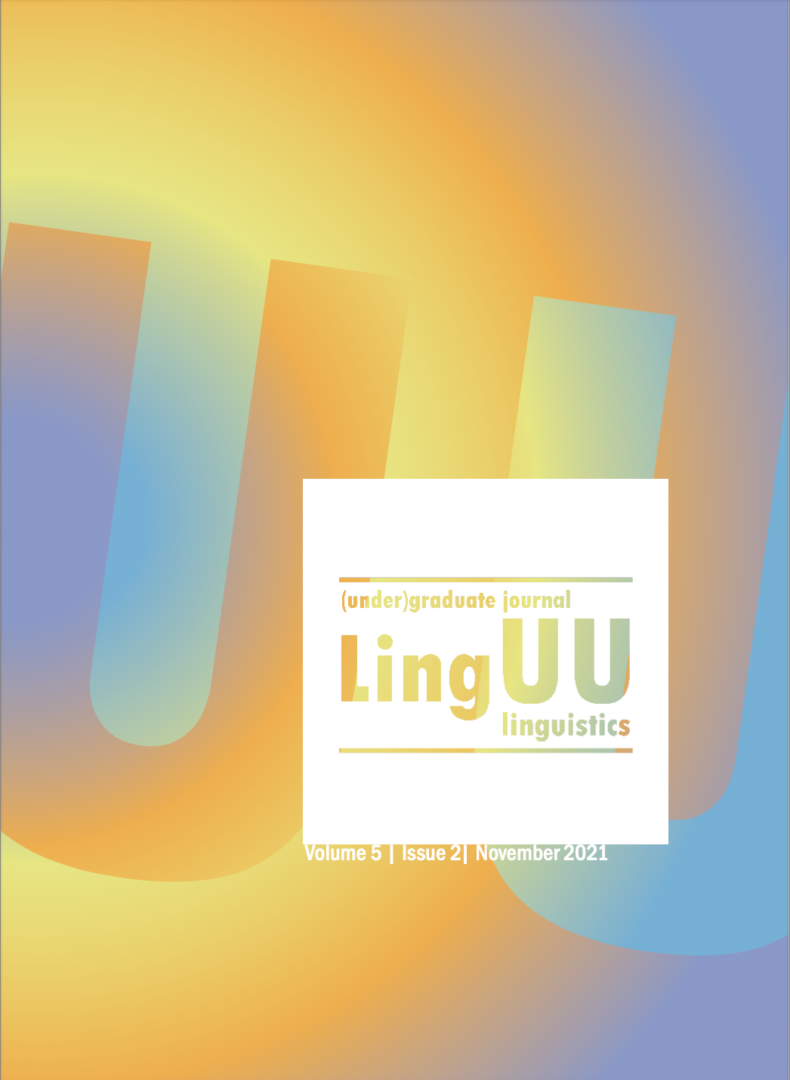
LingUU 5.2 is out now! The new issue of LingUU Journal features articles on various linguistic topics, written by students from different BA and MA programmes. Download the entire issue, browse through the contents, or order a paper copy (while supplies last).
Over the past two years, one of the most prevalent discussion topics in conversational settings has been the Covid-19 pandemic and its impact in our lives. Ellie Passmore touches upon this quite relevant topic, investigating whether there are differences in people’s rhetoric for Covid-19 based on their political leaning and age cohort in the USA. Exploring the possible effect of these two factors in Covid-19 language could have important implications in the improvement of online information services on that matter, targeting specific groups of people.
A paper by Angela Radić explores Pro-Drop in Dutch Heritage speakers of Serbian and to what extent these speakers master null subjects. Heritage speakers are an interesting subgroup of bilinguals, where the heritage language is only spoken at home (or in a community), and a second language is used in all other contexts. This means that heritage speakers use their heritage language at home and it is interesting to investigate, because it results in specific language patterns. This research explored the influence of L1 Dutch, a non-Pro-Drop language on L2 Serbian, a Pro-drop language and to what extent the pronominal subject is omitted. The results show that these speakers have no preference for either omission or inclusion.
Kalyon et al. ’s paper aims to find out if practicing code-switching in the Southeast Asian countries is similar to the one in the Northeastern countries, focusing on Indonesia.. English being the most switched-to language, interestingly, it is used frequently in Asian countries in recent years. Throughout the analysis section, several questions about the intensity of English and Indonesian language preferences on Indonesian TV and in other parts of life such as medical environments and schools were covered. To embody this, a survey was created to record responses from Indonesian locals. In the present study, the usage rates and forms of code-switching between English and Bahasa Indonesia are analyzed, discussed, and compared with similar uses of the concept in other cultures and countries.
Marijke van den Berg’s paper provides a critical review on Hu’s (2021) suggestion that subjectivity in Dutch connectives dus and daarom is not accompanied by prosodic marking. The author discusses possible limitations in Hu’s methodological approach which could have led to this conclusion. Crucially, she proposes a reanalysis of Hu’s findings, as well as an alternative experimental design which would control for the methodological weakness in Hu’s study.
Eleni Zimianiti investigates adjectival placement in Griko, an Italian-Greek variety, focusing on measuring adjectives in particular. Based on a written text from the 20th century, it is shown that adjectives in Griko could be found in prenominal position, which closes a data gap in the diachrony of the variety and highlights the strong contact of Greek and Italian.
Central in this paper by Carla Rijlaarsdam is the phenomenon of lexical cloning, which is discussed in terms of (neo-)Gricean principles. This paper focuses on the question in what insights the (neo-)Gricean principles can give on lexical cloning and its markedness. When a speaker uses lexical cloning in a conversation, it can be problematic to analyze it in terms of the principles of Grice. The form needs to be considered as a marked message, even though its meaning is not always marked.
There are many reasons why people want to learn a language and they are motivated by different elements. This article by Stephanie Bergmann explores the motivations and orientations of non-native Arabic learners in Jordan, with a comparison between colloquial Jordanian Arabic learners and Modern Standard Arabic learners. What are their reasons, interests, and attitudes to learn these languages? Through surveys and interviews it was found that the orientation integrativeness was more important than instrumentality for learning Arabic. It was also found that learning colloquial Jordanian Arabic was more important for communicative reasons and to be able to understand everyday conversations, but Modern Standard Arabic is also useful and play an important role in understanding the more standard media.
Renhao Pei’s paper is about scalar implicature and different pragmatic models that account for it. It discusses how four well-known pragmatic theories (traditional Gricean framework, Signaling Game, Iterated Best Response and Bayesian Inference) account for scalar implicature through concrete examples. By comparing how different models handle the same question, the paper demonstrates the merits and flaws that each model has, and how newer and more sophisticated models are proposed to tackle the problem that the previous model cannot solve.
This paper by Lotte Willemijn van Koppen explores the use of reflexive pronouns in L1 German speakers who speak Dutch. The German sich and the Dutch zich (‘-self’) might look the same but behave differently in both languages. Where in German sich is used in most reflexive contexts, Dutch makes a distinction between zich and zichzelf (‘himself’). This might lead to an overuse of zich by German speakers learning Dutch. An experiment was conducted where German speakers with varying degrees of Dutch proficiency had to correctly fill in zich or zichzelf in Dutch sentences to see if they could make the distinction between the two. The results show that there is a preference to use zich over zichzelf and it appears that proficiency levels play a role in this.
In this second special edition of Intern Extern two internships are discussed that were carried out during the pandemic. Agnė Župerkaitė internet at research project Drongo 2.0 at the Radboud universiteit. She came across it accidentally when she scrolled through websites of several universities. Eventhough she never saw her host supervisors in real life because of the pandemic, she was involved in every stage of the research. Carolin Tyrchan pursued an individual research project on syntax at the University of Cambridge. Despite not being able to visit the United Kingdom, she did not want to miss out on this opportunity.
The Daily Linguist of this issue highlights talks and panels that were posted on YouTube. Furthermore, the Language Neuroscience Podcast and the MPI Talking blog are highlighted.
LingUU 5.1 out now!
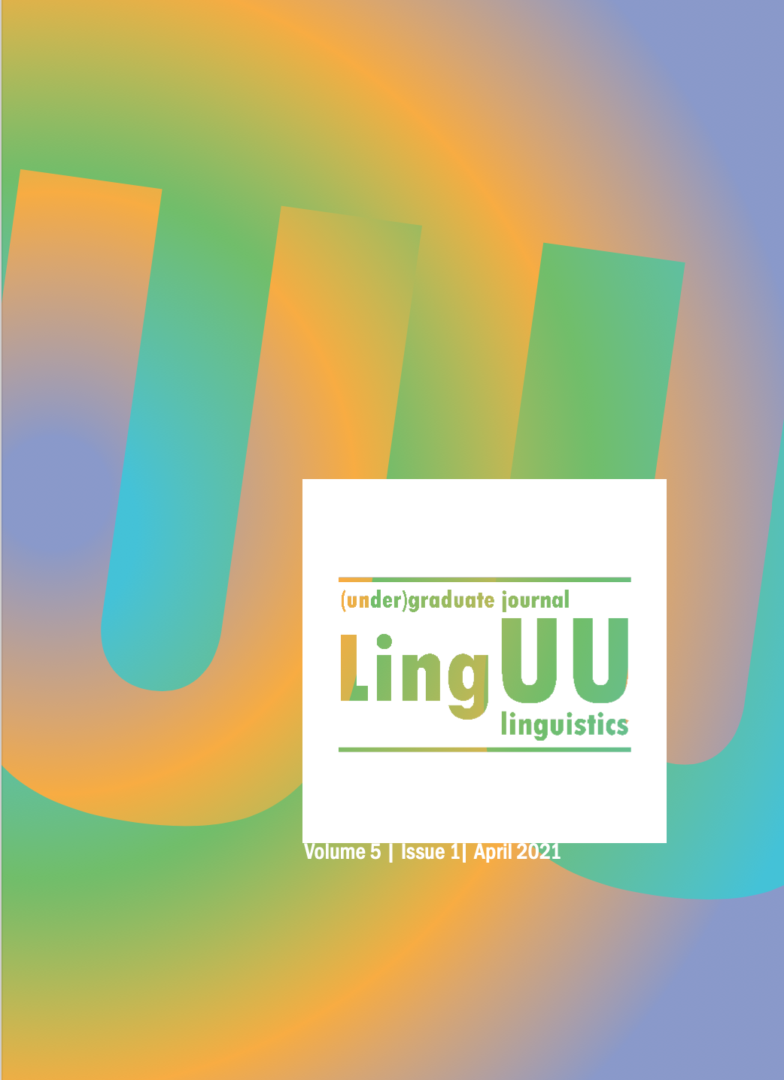
LingUU 5.1 is out now! The 9th issue of LingUU Journal features articles on various linguistic topics, written by students from different BA and MA programmes. Download the entire issue, browse through the contents, or order a paper copy (while supplies last).
The author of this paper, Carolin Tyrchan, wants to account for a parallel structural account of passives and antipassives in languages with a nominative-accusative and absolute-ergative system. The proposed suggestions are motivated by observations from case marking. Based on a critical review of previous accounts, this paper provides a first step towards a unified account of passives and antipassives across alignment systems. This account keeps the required syntactic operations at a minimum and, consequently, ensures simplicity.
Lila Oprins‘ paper deals with the diachronic semantic change of two verbs denoting taste in Dutch, smaken en proeven. Context is the key for discriminating which one is used when. The author explains why and how proeven takes over smaken nowadays by invoking semantics, but most importantly the syntax of the verbs. The exploration of the syntactic environment of the aforementioned verbs, provides illuminating insights on their change over time, recent use and preference of Dutch speakers, adding up to the chain of the verbs’ alternations and current employment.
Through a quest for symmetry, this paper by Lieke Hendriks explores the novel future-to–be construction (such as she is a bride-to-be). To find a theory to explain this construction in syntax, many analyses are examined, and other examples and data is used, because little is known about the future-to-be. Finally, small-clause formation was the best way to explain this novel construction. Small clauses allow subject and predicates to start in one constituent and refer to [NP XP]. To-be is the XP and through predicate inversion, the construction the soon-to-be bride is explained.
Georgios Chatzopoulos writes in Book Review about Wordcrime by John Olsson. This books goes into the world of forensic linguistics using 23 real life cases. According to Chatzopoulos, Olsson writes with passion and determination about what the true meaning of forensic linguistics is. A real recommendation for every reader interested in this relatively unexplored part of linguistics.
The Daily Linguist highlights upcoming conferences, podcasts and other online media about linguistics. In this issue the TABU day on June 10 and 11, the podcast Siencediction and a youtube channel with lectures about aphasia are mentioned.
LingUU 4.2 out now!
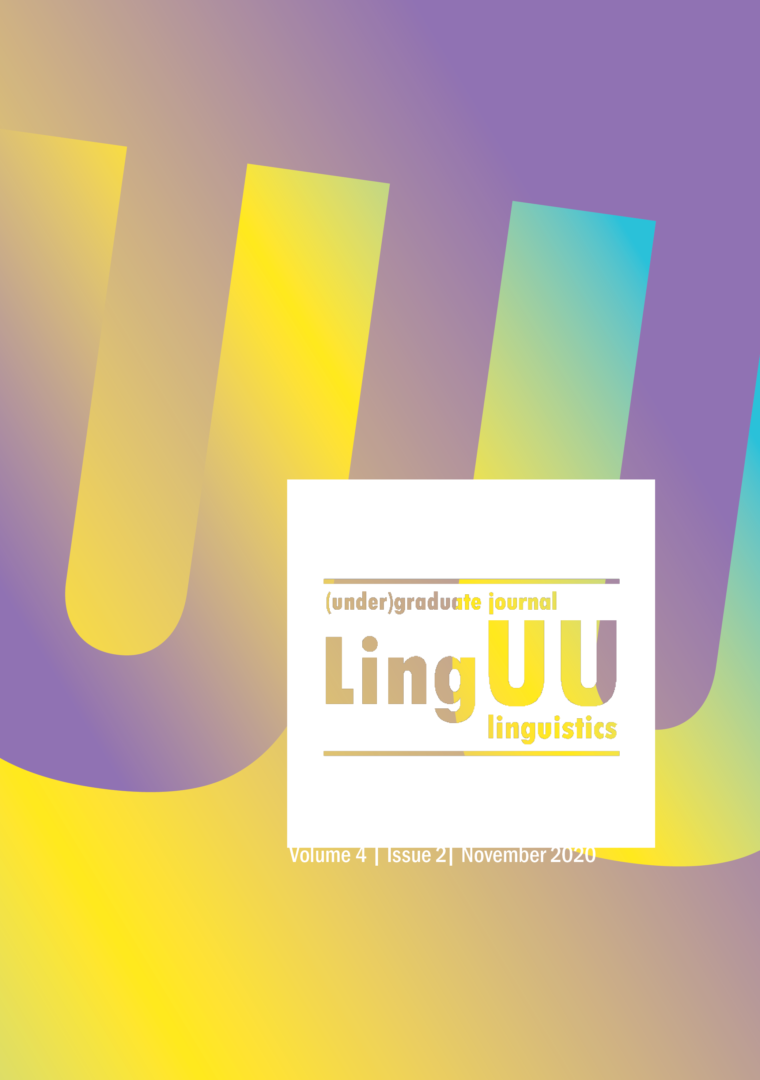
LingUU 4.2 is out now! The eight issue of LingUU Journal features articles on various linguistic topics, written by students from different BA and MA programmes. Download the entire issue, browse through the contents, or order a paper copy (while supplies last).
Iris van der Wulp discusses the influence of depression on language comprehension using the Affective Language Comprehension model. She examines both the role of depression in the recognition of (non-)verbal communication as well as what this means for how this is interpreted. Based on previous research, she concludes that depression results in a negative bias in the recognition of certain communicative signals. She argues that this can lead to a more negative interpretation of these signals and advocates more research into this question as to enhance communication with depressed individuals.
Rosanne van den Berg, Marian Marchal en Christina Papoutsi’sresearch paper investigates frequency effects on past tense verb retrieval. The authors examined whether highly frequent regular past tense verb are retrieved from declarative memory (i.e. directly), like irregular past tense verbs, instead of initially being decomposed in procedural memory. The authors expected to find an interaction between frequency effect and verb type. The results, however, did not support this hypothesis.
Süleyman Yaman covers the phenomenon of zero morphemes in Turkish relative clauses. Due to the agglutinative morphology, Turkish does not have many zero morphemes. This study hypothesizes that case markers (i.e. comitative, dative, locative and ablative) are omitted in Turkish relative clauses. The analysis showed that the case markers normally available on the independent clauses were omitted when they merged to form a relative clause.
Children who do not acquire a tone language seem to first lose their sensitivity for tonal contrasts, before regaining it at a later age. Why this sensitivity recovers, is still unclear. Zhou Yang proposes a research to examine this issue using near infrared spectroscopy, a technique that measures brain activity, with children of different age groups. He argues that different parts of the brain are active when discriminating tone contrasts than when using these tones in word learning. By comparing (brain) responses to tone contrasts by children of different age groups, this research will provide more insight into how children acquire the use of tone in their native language.
Marjolein Talsma (RMA Linguistics) shows that a variety of languages allow for D(iscourse)-linked wh phrases to be extracted out of DPs. This is unexpected, as these DPs are considered phases and should therefore not allow movement. The author extends Van Craenenbroeck’s (2004) analysis of complex wh phrases to the case of D-linked wh phrases and argues that they are base generated in the left periphery. As such, they do not undergo movement and the grammaticality of these constructions is accounted for.
Annika Hulzebos (RMA Linguistics) interned at volunteer organisation Taal doet meer in Utrecht during her master Meertaligheid en Taalverwerving. In her internship she wanted to combine language and health. With her internship she could contribute to society and have an experience outside of the ‘academic bubble’.
And finally, our column The Daily Linguist is all about language related movies, documentaries, blogs, applications and events.
Taal Taal

Vertalingen
| Voeg een vertaling toe in Nederlands | Vertaling |
LingUU 4.1 out now!
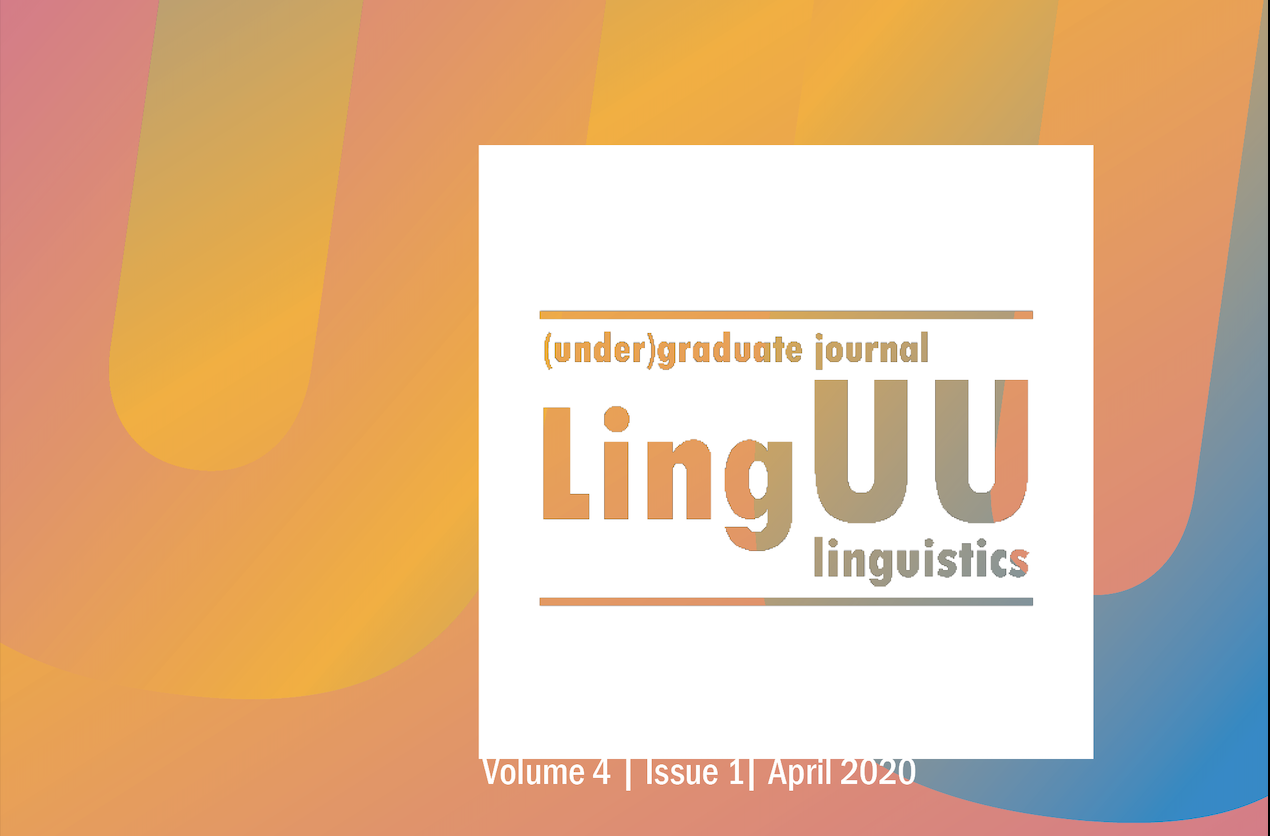
LingUU 4.2 is out now! The sixth issue of LingUU Journal features articles on various linguistic topics, written by students from different BA and MA programmes. Download the entire issue, browse through the contents, or order a paper copy (while supplies last).
Marian Marchal (RMA Linguistics) examines the acquisition of sentences containing both a modal verb as well as negation. She argues that a stage of Unique Scope Assignment might not be necessary to explain Italian-acquiring children’s interpretation of these sentences. An experiment is proposed to investigate whether children are able to access the adult-like interpretation if additional processing cost is controlled for.
Bjorn Lichtenberg(RMA Linguistics) discusses how language has evolved by reviewing the cultural approach to this question. After outlining how language is viewed in this approach, research in favor of this theory is examined, In addition, the author reviews the validity of claims favoring a biological approach. The paper reveals that the cultural approach is able to explain many aspects of language evolution.
Lex Tavenier(RMA Linguistics) analyzes a construction which is typical for creole languages, namely, serial verb constructions. Serial verb constructions consist of at least two consecutive verbs while only one grammatical subject is present. The verbs enter into complex syntactic and semantic relationships. The author considers a couple of possible syntactic analyses for the serial verb construction and comes to conclude that the findings are compatible with both analyzing the construction as serialized IPs and with analyzing it as serialized VPs, though statistical corpus analysis seems to suggest the VP-serializing to be more probable.
Vanessa Kühn (RMA Linguistics) further investigates the way in which clinical symptoms of schizophrenia are reflected in language. Especially central in her paper is the link between clinical symptoms and the emotion word usage of patients. She presents two examples of the untypical emotion word use in patients and combines these insights with the emotion processing model by Vingerhoets et al. (2000). Using this model, Kühn illustrates the influence of clinical symptoms of schizophrenia on general emotion processing further.
Beactrice Bancheri (RMA Linguistics) discusses the importance of emotion in the acquisition of a first language. Based on a model on human cooperation, Bancheri shows that emotion and language are closely intertwined. In addition, she discusses several aspects of language acquisition, such as infant-directed speech and word learning, in which emotion plays a prominent role.
Elina van Greuningen (RMA Linguistics) interned at the Humboldt Universität in Berlin. Here she researched the effect of the similarity between the German and Dutch language on the acquisition of gender in Dutch. In addition to her research experience, her stay in Germany was a special cultural experience with the 30th anniversary of the fall of the Berlin Wall.
Anouschka van Dijk (Msc Neuroscience and Cognition) discusses the film The Silent Child by directors Chris Overton en Rachel Shenton. This film follows a family with a four year old child named Libby who was born deaf. When the family hires a social worker who teaches Libby sign language, the new ability to communicate opens up a new world for her. Anouschka recommends the film to those who are interested in the obstacles a deaf person faces and those who are looking for a new perspective on the importance of language and communication.
And finally, our column The Daily Linguist is all about language related movies, documentaries, blogs, applications and events.
LingUU 3.2 out now!
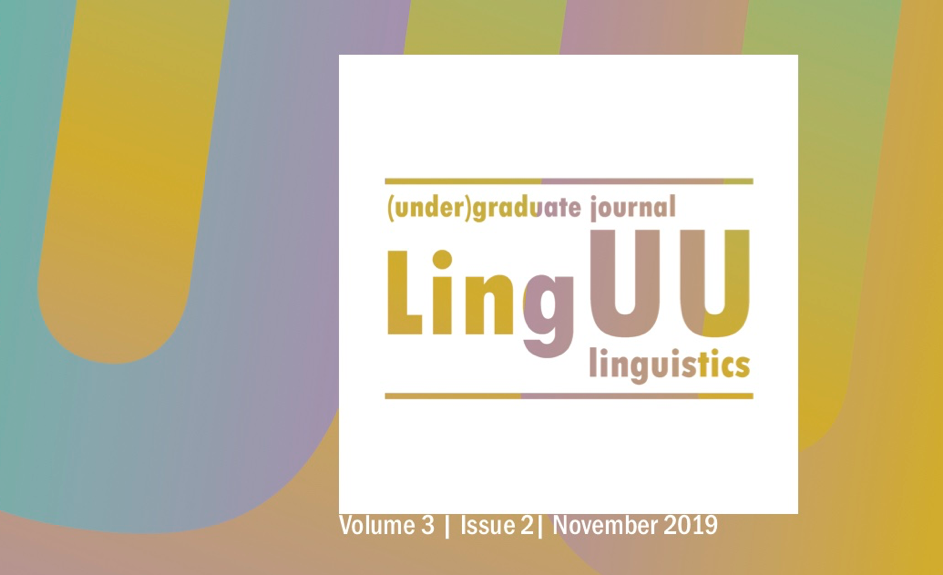
LingUU 3.2 is out now! The fifth issue of LingUU Journal features articles on various linguistic topics, written by students from different BA and MA programmes. Download the entire issue, browse through the contents, or order a paper copy (while supplies last).
Walther Glödstaf (RMA Linguistics) discusses long distance case assignment on Finnish direct objects. It has been argued that they violate the Phase Impenetrability Condition, stating that operations cannot take place across multiple phases (Brattico, 2014). He proposes an analysis to show that this is actually not the case using data from Finnish relative clauses.
Sanne Ditewig (RMA Linguistics) proposes a study on children with ALI (Autism Language Impairment) and their knowledge of the constraints on the binding of reflexives. Previous research has shown that children with ALI do not have full knowledge of the constraints on the binding of reflexives, however this was only tested for the c-command constraint of Principle A. Sanne suggests to also look at the locality constraint of Principle A, in order to investigate the nature of this impairment.
Judith Brinksma and Nelleke Jansen (RMA Linguistics) report on their study on phonetic convergence of students who are originally from Limburg and now live in Utrecht. They compare these students’ pronunciation of two phonemes, /ɣ/ and /v/, with that of students who are raised in Utrecht in two tasks: reading a word-list out loud and a socio-linguistic interview. Factors affecting the differences in convergence found between the participants are also discussed.
Milou Leeijen (MA Meertaligheid en Taalverwerving) examines
non-standardized dialects in Northern Brabant. Leeijen focuses primarily on morfo-syntactic similarities and differences between the Noord-Meierijs and Kleverland dialects. Topics discussed include: doubling of the subject, double negation, adjectives, the inflection of pronouns and the inflection of articles. This should result in either finding a clear boundary between both dialects or discovering that both dialects have influenced each other.
Dylan Bonga (RMA Linguistics) analyzes two programs which can be used to classify errors that second language learners make in the correct use of prepositions. He suggests that while these programs both perform quite well, their recall levels constitute something that might be improved upon. To solve this problem, Bonga proposes to incorporate the effect of native language transfer into error classification programs.
The guest paper by Nizar Hirzalla (MSc Artificial Intelligence, Vrije Universiteit Amsterdam) discusses the linguistic characteristics of social media text messages from populist parties. Through a computational analysis using different kinds of Natural Language Processing (NLP), the rhetorical and linguistic patterns have been detected. The analysis is based on a comparison between two Dutch populist parties, PVV and Identitair Verzet and an upcoming party, The Yellow Vest Movement.
Janna van Egmond (MA Taal- en Spraakpathologie) interned at the UMC in Utrecht where she worked on data collection for research on speech in various psychiatric disorders. During this time she also worked on her own Bachelor’s thesis about language in schizophrenic patients.
Roos Kerrebijn (BA Dutch Language and Culture & BA Linguistics) discusses The Infinite Gift by Charles Yang which is about the impressive language abilities of children. Roos invites all to read the book because of its writing style and Yang’s knowledge of his field and adjacent fields.
Finally, we have a little surprise: this issue contains our brand new section,The Daily Linguist!
New editors wanted
Dear fellow linguists,
Our university has its very own (under)graduate journal for linguistics: LingUU Journal. This is a journal where you, students, can publish papers you are proud of, or papers in which you show something that more people should read, other than just your teacher.
Since the academic year is progressing swiftly, we are looking for new members for our editorial board!
What can LingUU Journal offer you?
A position in the editorial board of LingUU offers the possibility to take a look inside the organisation of scientific publications, gain knowledge on good (academic) writing and develop your organisational abilities.
Interested? We are looking for students that would like to fill the following positions:
- Senior editor (division of tasks regarding submitted manuscripts, keep track of the status of manuscripts, assistance of the editors in chief, various other editorial tasks)
- Secretary(write minutes, create and manage archives, manage e-mails and distribute the issues)
- Treasurer (attracts financial support, takes care of orders and manages the budget of the journal)
- Designer & webmaster (management of the journal’s layout and website)
- Editor (search for and approach contributors, solicit manuscripts, revise submitted content)
Are you interested in linguistics, science in general, and the distribution of knowledge, and would you like to be involved in a student journal? Send an e-mail to linguu.gw@uu.nl before June 12, 2019. Your e-mail must consist of the following parts:
- Name and surname;
- Current study;
- Field(s) of interest within linguistics (e.g. phonetics);
- Post(s) of interest;
- Short motivation;
- An indication of the time you would like to be part of the board (e.g. one year).
Please feel free to contact us if you have any questions at all. We are looking forward to see your application.
Warm regards,
Mandy de Kuiper and Myrthe van der Veen
Editors in chief of LingUU: (undergraduate) journal of Linguistics
Call for Papers – November 2018
Have you written a linguistics paper, research proposal or thesis you are proud of? Consider submitting your work to LingUU, the official, peer reviewed, student journal of Linguistics at Utrecht University. In this journal, both undergraduate and graduate students can publish their papers.
The deadline for the next Call for Papers is November 11, 2018.
Why should I submit?
Students sometimes come up with ideas that are worth sharing, and develop creative theories that more people should read, other than just the teacher. LingUU provides a way to make this happen, while giving students the opportunity to get to know the world of academic publishing small-scale. Publishing in LingUU is a great learning experience for starting academics and enables you to improve your work through peer feedback.
What can I submit?
LingUU features articles from all subdisciplines of linguistics and publishes in both Dutch and English. Apart from full-blown articles, research proposals are also welcome for submission. Besides scientific articles, you can submit reports on internships abroad and book notices.
You can find examples of published articles in our first issue.
How do I submit?
You want to submit; that’s great! Please read our guidelines for authors first, to make sure your work meets our requirements. Next, submit it through our online form, on November 11 at latest. Within a few days after the deadline, you’ll receive more info about the reviewing and publication process.
If your paper is accepted (after revision), it will be published in the issue of April 2019, or in November 2019.
Questions?
If you have questions left, do not hesitate to contact via linguu.gw@uu.nl. You can also check the frequently asked questions first.
We’re looking forward to receiving your paper!


